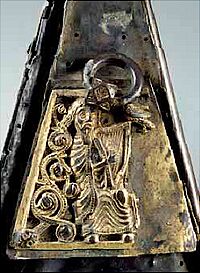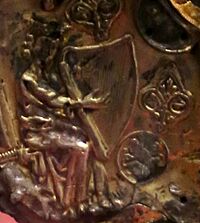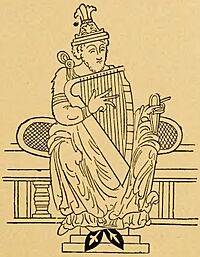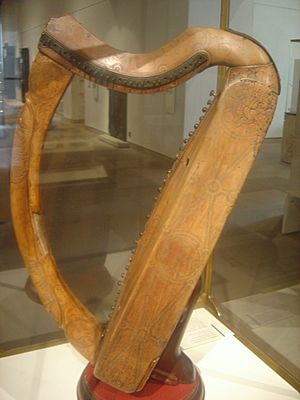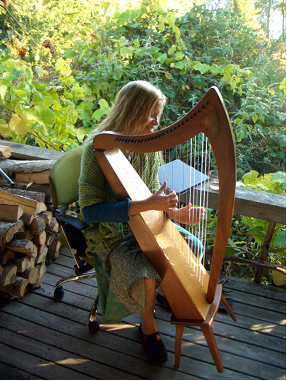Celtic harp facts for kids
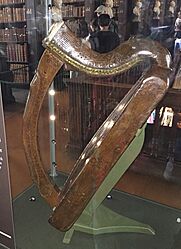
The famous 'Brian Boru's harp' (Cláirseach Brian Bóramha) on display in the Library of Trinity College Dublin
|
|
| String instrument | |
|---|---|
| Other names | cláirseach, clàrsach, telyn, telenn |
| Classification | |
| Hornbostel–Sachs classification | 322.221 (manually tuned frame harp) |
| Related instruments | |
|
|
The Celtic harp is a special kind of harp that has been played for a very long time in the Celtic nations of northwest Europe. These countries include Ireland, Scotland, Wales, and Brittany (in France). It has different names in these languages: cláirseach in Irish, clàrsach in Scottish Gaelic, telenn in Breton, and telyn in Welsh. In Ireland and Scotland, it was traditionally played with wire strings and required a lot of skill. It was often played for important people and leaders. Today, you can see the Celtic harp on Irish money, on Guinness products, and as a symbol on the coats of arms for Ireland, Montserrat, Canada, and the United Kingdom.
Contents
Early History of the Celtic Harp
- Further information: Origin of the harp in Europe and Rotte (lyre)
| Irish harping | |
|---|---|
|
UNESCO Intangible Cultural Heritage
|
|
| Country | Ireland |
| Reference | 01461 |
| Region | Europe and North America |
| Inscription history | |
| Inscription | 2019 (14th session) |
| List | Representative |
The exact beginning of the triangular frame harp in Europe is a bit of a mystery. One of the earliest instruments linked to harping in the Gaelic world was called a cruit. This word might have first described a different stringed instrument. Later, the word clàrsach or cláirseach was likely used for the triangular harp that became popular.
Some of the oldest pictures of triangular harps in Europe are found on carved stones made by the Picts in Scotland, dating back to the 8th century. These early Pictish harps used strings made from horsehair. It seems these instruments then spread to other parts of Europe, including Ireland.
In Ireland, stringed instruments were mentioned as early as the 6th century. Musicians who played them were highly respected by the leaders of that time. Ancient Irish rules from around 700 AD said that poets and 'cruit' players should sit with important people at feasts, not with regular entertainers.
The first clear pictures of the Irish triangular harp appear much later, around the 11th and 12th centuries. A famous writer named Gerald of Wales (who lived from about 1146 to 1223) wrote about Irish harp music. He said that the Irish were incredibly skilled at playing musical instruments, more so than any other nation he had seen!
The only thing to which I find that this people apply a commendable industry is playing upon musical instruments… they are incomparably more skilful than any other nation I have ever seen
However, Gerald also mentioned that, in "the opinion of many," the Scots and the Welsh had become even better at this skill.
Three very old and real harps from before the 16th century still exist today. They are the Brian Boru Harp in Dublin, and the Queen Mary and Lamont Harps in Scotland. These harps are about 500 years old and might have been made in western Scotland.
One of the most famous composers for the harp was Turlough O'Carolan. He was a blind Irish harper who lived in the 17th and 18th centuries. He wrote at least 220 songs that we still know today!
Welsh Harps: The Telyn
See: History of the harp in Wales
In Wales, the harp is called telyn. There were different kinds, like the telyn benglin (lap harp) or telyn rawn (harp with horsehair strings). Welsh harps were often mentioned in stories and writings starting around the 12th century.
Like the Irish, the Welsh also had harps with metal strings. But they often preferred horsehair strings, unlike many other parts of Europe that used gut strings. Welsh harps were made of wood, had a soundboard from animal hide, and about 30 horsehair strings. They were played on the musician's left shoulder. Over time, new types of harps became popular in Wales, but many harpists today feel a strong connection to this ancient tradition.
What Makes the Celtic Harp Special?
By the 1500s, most Celtic harp strings were made of brass. Today, people experiment with different metals like copper, silver, and even gold for strings. The strings are attached to a soundbox, which is usually carved from a single piece of wood, often willow. The Celtic harp also has a strong curved pillar and a thick neck.
A unique thing about playing this harp is that musicians use their long fingernails to pluck the strings! Also, in this type of harp, the first two strings in the middle of the musical range were tuned to the exact same pitch.
Parts of the Harp
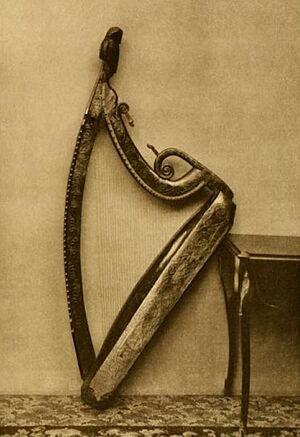
Here are the main parts of a Celtic harp:
| Irish | Scottish Gaelic | English |
|---|---|---|
| amhach | amhach | neck (the part that holds the tuning pins) |
| cnaga | cnagan | pins (used to tune the strings) |
| corr | còrr | pin-board (where the pins are located) |
| com | com | chest or soundbox (the hollow part that makes the sound louder) |
| lámhchrann | làmh-chrann | tree or forepillar (the front support of the harp) |
| téada | teudan | strings (what you pluck to make music) |
| crúite na dtéad | cruidhean nan teud | string shoes (small pieces that protect the wood where strings attach) |
| fhorshnaidhm | urshnaim | toggle (a small wooden piece that helps hold the string) |
The com (soundbox) was usually carved from one piece of willow wood, hollowed out from the back. A panel of harder wood was then carefully put in to close the back. The crúite na dtéad (string shoes) were often made of brass. They stopped the metal strings from cutting into the wood of the soundbox.
How to Play the Harp
Playing the wire-strung harp was known to be quite challenging! Because the wire strings would ring for a long time, the player had to gently stop the sound of strings they had just played, while also plucking new ones very quickly. Unlike how many modern instruments are played, the left hand played the higher notes, and the right hand played the lower notes. It was often said that a person should start learning the harp by age seven to become very good. However, today's skilled players show that you can become good even if you start later!
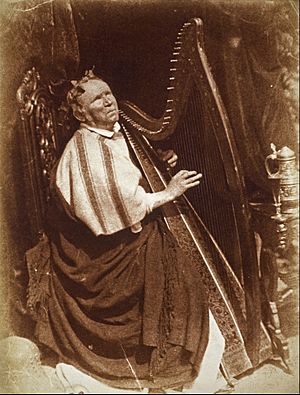
The Harp's Place in Society and Its Changes
For a long time, the wire-strung harp was very popular across the Gaelic lands of Scotland and Ireland. Harpers (harp players) had a high social standing and were respected members of society. Even new settlers in Ireland enjoyed and supported harp music until the late 1700s.
A famous Gaelic poet named Màiri Nic Leòid (who lived from about 1615 to 1705) wrote songs that show how important the harp was. She praised leaders who were good at judging harp playing. Her songs also described how the music of the harp and bagpipe added to the splendor of important gatherings, along with wine in shining cups.
We may note as a remarkable fact that the descendants of Protestant settlers, who had been at most for three generations in the country, seem to have been just as devoted to the Irish music of the harp as were the old Gaelic families.
Over time, other instruments like the great Highland bagpipe and the fiddle became more popular. This meant that the harp's special place in society slowly changed. There's even evidence that the way bagpipes were played and the songs they played were influenced by the harp tradition.
Many names of the last traditional harpers were recorded. People like Duncan McIndeor, Patrick McErnace, and Rory Dall Morison were famous harpers in the 17th and 18th centuries. But by the mid-1700s, fiddle players had largely taken the place of harpers.
Bringing the Harp Back: A Revival
Even as the old Gaelic harp tradition was fading, a new kind of harp was created in Ireland in the early 1800s. This new harp had gut strings and special parts to change notes, similar to a modern orchestral harp. It was made by John Egan in Dublin.
This new harp was smaller and curved, much like the old Irish harps, but it had gut strings and a lighter soundbox. In the 1890s, a similar new harp became popular in Scotland as part of a movement to bring back Gaelic culture.
Today, there is a lot of renewed interest in the original wire-strung harp. People are making copies of these ancient instruments and studying old playing techniques. A big event for the Celtic harp is the Edinburgh International Harp Festival, which has been held every year since 1982. It features performances and workshops where people can learn more about this wonderful instrument.


